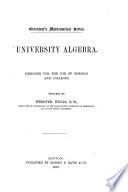 | Webster Wells - Algebra - 1879 - 468 pages
...where a has been transposed to the second member by changing its sign. 174. Hence the following BULE. Any term may be transposed from one member of an equation to the other, provided its s1gn be changed. 1. In the equation 2x — 12 + 3 = £c — бж + 9, transpose the unknown... | |
 | Robert Fowler Leighton - 1880 - 428 pages
...what ? (a;"1 X z")3 = what ? (a2 6)m = ? y(^) = ? What is denoted by ai ? 10. What is the reason that any term may be transposed from one member of an equation to the other, provided its sign is changed ? 11. Solve the equation r—. = ;. What is aa -If- ba — o the value... | |
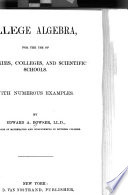 | Edward Albert Bowser - Algebra - 1888 - 868 pages
...other. It is evident that similar steps may be employed in all cases. Hence we have the following RULE. Any term may be transposed from one member of an equation to the other by changing its sign. It follows from this that the sign of every term of an equation may be cJianged; for this is equivalent... | |
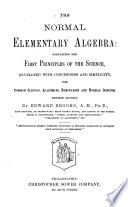 | Edward Brooks - Algebra - 1888 - 190 pages
...one member to the other, the sign of the quantity is changed ; hence the following rule. Rule. — A term may be transposed from one member of an equation to the oiher, if, at the same time, the sign be changed. EXAMPLES. In the following examples transpose the... | |
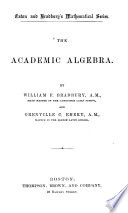 | William Frothingham Bradbury, Grenville C. Emery - Algebra - 1889 - 428 pages
...which disappears from one member of an equation, reappears in the other with the opposite sign. Hence, any term may be transposed from one member of an equation to the other, provided its sign is cluinyed. It follows from this that the signs of all the terms of an equation... | |
 | James Morford Taylor - Algebra - 1889 - 340 pages
...(2) are equivalent equations. 132. COROLLARY. By the principle of § 131 we may transpose any term from one member of an equation to the other by changing its sign. For this is the same thing as adding to both members the term to be transposed, with its sign changed.... | |
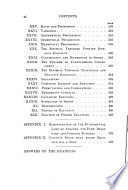 | Webster Wells - Algebra - 1890 - 560 pages
...of an equation without destroying the equality. 88 COLLEGE ALGEBRA. 181. Transposition of Terms. A term may be transposed from one member of an equation to the other by changing its sign. For, consider the equation x + a = b. Subtracting a from Iwth members (Art. 180), we have xfa — a=6... | |
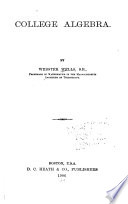 | Webster Wells - Algebra - 1890 - 604 pages
...same quantity without destroying the equality. lei. Transposition of Terms. A term may be transponed from one member of an equation to the other by changing its sign. For, consider the equation x + a = b. Subtracting a from both members (Art. 180), we have ж + a —... | |
 | William James Milne - Algebra - 1892 - 370 pages
...quotients will be equal. 6. Equal powers of equal quantities are equal. 58. PRINCIPLE. — A quantity may be transposed from one member of an equation to the other by changing its sign from + to —, or from — to +. EQUATIONS AND PROBLEMS. 59. 1. 2 x — 3 = x + 6. Find the value of... | |
 | William James Milne - Algebra - 1894 - 216 pages
...by equals, the quotients are equal. 6. Equal powers of equal quantities are equal. 49. PRINCIPLE. A term may be transposed from one member of an equation to the other if its sign is changed from + to — , or from — to +. 43 EQUATIONS AND PROBLEMS. 50. 1. Given 2x... | |
| |